MSU helms $15 million to project to help make fusion energy a reality
Michigan State University’s Andrew Christlieb is leading a massive U.S. Department of Energy project to help deliver on the not-yet-realized promise of nuclear fusion. That promise? To create an unmatched source of affordable and sustainable energy.
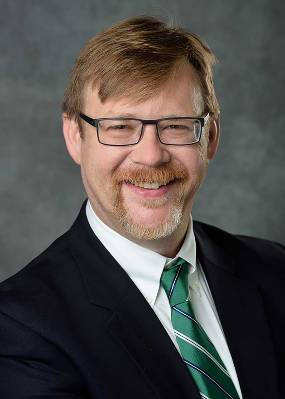
MSU Foundation Professor Andrew Christlieb. Credit: Derrick Turner
Christlieb, an MSU Foundation Professor in the College of Natural Science, is now the director of a Mathematical Multifaceted Integrated Capability Center, or MMICC, supported by $15 million in funding from the DOE. He is joined by researchers at eight other universities and national labs across the country. Together, they’re developing new mathematical and computational tools to better model the physics needed to understand, control and sustain fusion.
The MSU-led center is one of four new MMICCs announced by the DOE.
“MMICCs enable applied mathematics researchers, working in large, collaborative teams, to take a broader view of a problem,” said Barbara Helland, DOE associate director of science for the Advanced Scientific Computing Research program, in a recent news release. “As a result of this holistic view, the researchers devise solutions by building fundamental, multidisciplinary mathematical capabilities considering existing and emerging computing capabilities.”
“We’re going to be pushing the boundaries of what can be done mathematically and computationally,” said Christlieb, who is a professor in the Department of Mathematics and the Department of Computational Mathematics, Science and Engineering.
In addition to MSU’s contingent of experts, the team includes collaborators from Lawrence Livermore National Laboratory, Los Alamos National Laboratory, Oak Ridge National Laboratory, Sandia National Laboratories, the University of Colorado-Boulder, the University of Delaware, the University of Massachusetts-Dartmouth and the University of Washington.
“We’re asking ourselves how do we engage with things like machine learning? How do we engage with bigger, more powerful computers? How do we engage with new mathematical algorithms?” Christlieb said. “We have this lofty goal of taking a bird’s-eye view, looking down on all these different pieces and understanding how they fit together to solve big problems.”
As one might imagine, simultaneously pushing the boundaries of math, computation and nuclear fusion is full of complex technical challenges.
Fortunately, understanding the bigger picture of what this MMICC can deliver does not require advanced mathematics or sophisticated algorithms. In fact, whether they know it or not, everyone on this planet already has an appreciation for the impact of fusion.
Harnessing the power of the sun
What Christlieb and his colleagues are trying to do is help power the planet using the same science that powers the sun: nuclear fusion. To do this, the team is working to bring new computational tools and techniques to bear on understanding the plasmas needed to sustain fusion.
The sun itself is a ball of mostly plasma, a cloud of matter so hot that its atoms have started shedding the electron cloaks that surround their cores, or nuclei. Within the burning plasma, nuclei can collide and fuse together.
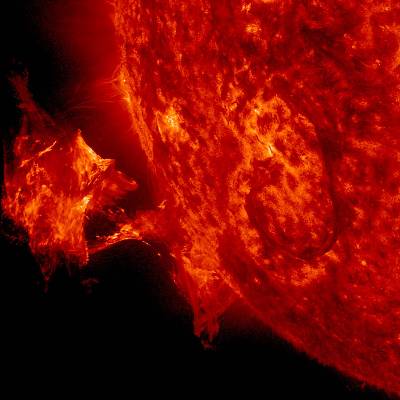
The sun, which is itself a giant orb of plasma, ejects a comparatively smaller glob of plasma. Credit: NASA Solar Dynamics Observatory
These fusion events release a ton of energy, which keeps the plasma burning and empowers subsequent fusion reactions. The sun and its fusion are thus self-sustaining, like an enormous fire that stokes itself and showers the solar system with light and heat.
For decades, humanity has been trying to replicate what the sun does at a much smaller scale to help meet the world’s energy needs. Scientists achieved their first fusion reaction in the 1930s.
In the nine decades since, however, researchers have yet to ignite self-sustaining reactions that reliably generate more energy than they consume. One of the hurdles has been understanding the plasmas involved well enough to control and optimize them.
By the early 2000s, plasma and fusion researchers had seen enough dead ends and false starts that many began to doubt people would ever realize this untapped potential. That included Christlieb’s doctoral adviser.
“He advised me to not work on fusion. At the time, it seemed that the plasma community had lost its way, and fusion just wasn’t going to produce energy,” Christlieb says. But things started to change as the 21st century progressed, and researchers brought fresh insights to the field.
“Technologies we thought were dead all of a sudden became more interesting,” Christlieb says.
With that, there’s a renewed sense of optimism and urgency about fusion. In March of this year, the White House hosted a summit focused on accelerating the development of fusion energy. There are also more than a dozen start-up companies in the U.S. and Canada currently developing fusion-related technology.
“Some of these are really exciting,” Christlieb says. “I really believe fusion energy is on the horizon.”
Questions about plasmas, however, still loom large. That’s why the DOE is investing $15 million in a center that will help answer them.
“It really behooves us to use our resources wisely and enable things that weren’t possible before,” says Luis Chacon, co-director of the new MMICC, which the team has named the Center for Hierarchical and Robust Modeling of Non-Equilibrium Transport, or CHaRMNET. Chacon is a leading expert in modeling plasmas for fusion in the Theoretical Division at Los Alamos National Laboratory.
“You have to be ambitious. What we’ve proposed is a real departure from the current state-of-the-art and, any time you do that, it’s like jumping from a plane,” he says. “You hope the parachute opens, and you try to land in a good place.”
Teamwork makes the plasma dream work
With that analogy in mind, it’s easy to understand Chacon’s feelings as the project gets going.
“It’s elation mixed with adrenaline and a little bit of ‘What the heck am I getting into?’” he says, which is a little surprising to hear, given the calm confidence with which he says it.
Partially, that confidence comes from experience. Jumping into the unknown is what you do as a scientist, he says. But another crucial factor is the team.
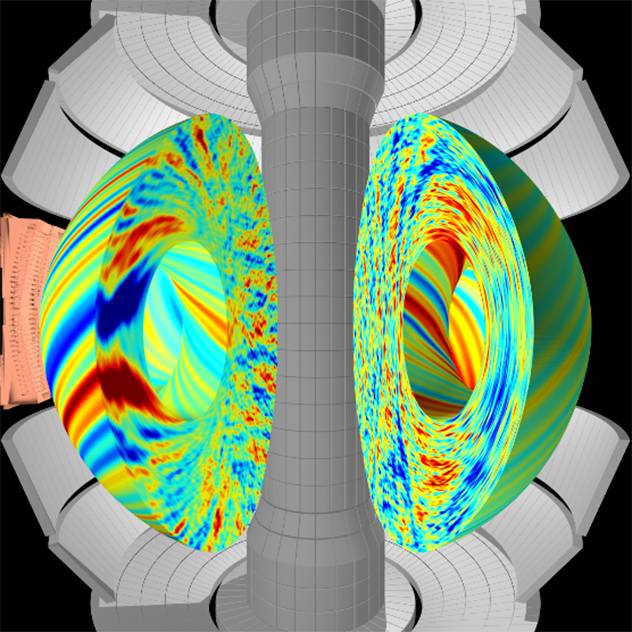
A computer simulation of plasma inside a device called a tokamak, one of the leading technologies in development for fusion energy. Credit: Walter Guttenfelder/Princeton Plasma Physics Laboratory and Filippo Scotti/Lawrence Livermore National Laboratory
“The sheer quality of this team is massive. We found the highest quality people we could for this project,” Chacon says. Including Christlieb and Chacon, the team includes 20 investigators and their teams.
Joining the team from academia are Yingda Cheng, Huan Lei and Brian O’Shea from MSU; David Bortz and Stephen Becker from the University of Colorado-Boulder; Jingmei Qiu at the University of Delaware; Sigal Gottlieb from the University of Massachusetts-Dartmouth; and Jingwei Hu from the University of Washington.
The team’s national lab cohort includes Joshua Burby and Qi Tang from Los Alamos National Laboratory; Youngsoo Choi, Terry Haut, Jeffrey Hittinger, Lee Ricketson and Paul Tranquilli from Lawrence Livermore National Laboratory; Cory Hauck from Oak Ridge National Laboratory; and John Jakeman and Timothy Wildey from Sandia National Laboratories.
“This is the largest and highest-profile project that I’ve ever been a part of,” says Wildey of Sandia, who is an expert in machine learning and uncertainty quantification. He’s also a Spartan alumnus who graduated as part of the class of 2001 with a bachelor’s degree in mathematics.
“Just with the size and dispersity — we’re spread across nine different institutions — there will be challenges. But they’re challenges we’re looking forward to,” Wildey says. “We have an absolutely amazing team. That’s why we were successful in getting this opportunity and why I believe we’ll be successful with our project.”
Which begs the question, what does success look like and what makes achieving it so challenging?
Taming the curse of dimensionality
Wildey has a concise way of summing up the research team’s goals. The center was created to provide end-to-end computational approaches that enable fusion researchers to simulate plasmas quickly, completely and reliably enough that they can use the results to make important decisions in real time.
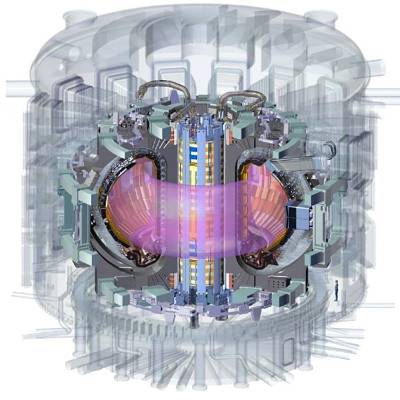
A schematic of the International Thermonuclear Experimental Reactor, with its confined plasma shown near the middle in light purple. Credit: U.S. ITER
In particular, the team is focusing on plasmas found in two approaches that are in development to achieve fusion energy. One is called magnetically confined fusion energy. This is the approach behind a new thermonuclear plasma confinement record.
It’s also the approach used by the world’s largest fusion experiment, the International Thermonuclear Experimental Reactor, or ITER. ITER is located in France and is a collaboration between 35 countries, including the U.S.
The other approach is called inertial confinement fusion energy, which is the idea behind the National Ignition Facility, or NIF, at Lawrence Livermore National Laboratory, or LLNL.
Although NIF won’t be relied on to produce energy, it allows researchers to explore a fusion approach that bombards a target with energy from virtually every angle, essentially squeezing the target’s nuclei until they fuse.
At NIF, that energy is supplied by 192 lasers. The facility created its first burning plasma last year.
“We’re close to achieving fusion in the laboratory but optimizing the processes and operation of fusion reactors will require better modeling,” says Jeffrey Hittinger, director of the Center for Applied Scientific Computing at LLNL and one of the core group members behind the CHaRMNET proposal. “There’s a nice parallel here with the Wright brothers.”
Though famous for flight, the brothers weren’t the first humans to fly.
“Getting into the air wasn’t the issue,” Hittinger says. “Controlling the flight was the Wright brothers’ big breakthrough.”
Without that control, aircraft wouldn’t have become an essential part of our transportation system. Similarly, gaining control of plasmas is a large and necessary hurdle that researchers must clear to establish fusion as a reliable energy source.
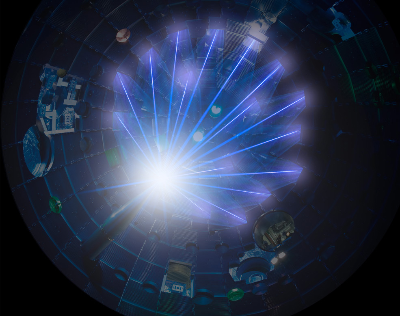
Nearly 200 lasers converge on a target in the National Ignition Facility at Lawrence Livermore National Laboratory, letting researchers explore inertial confinement fusion. Credit: Lawrence Livermore National Laboratory
“Plasmas are fluids with attitude. They don’t passively resist,” Hittinger says. “If you’re trying to control a plasma, it has so many mechanisms by which it can thwart you.”
Researchers have been developing computational models to better understand plasmas and enable that control for decades, but the models inevitably use simplifying assumptions to make the problems tractable.
CHaRMNET is leveraging the latest advances in algorithms, methodology, high-performance supercomputing and more to create approaches that don’t simplify the physics. That requires confronting numerous problems head-on, such as the gargantuan range of scales that need to be considered.
Nuclei — the things that are actually fusing — are a quadrillionth of a meter in diameter. Put another way, they’re a heck of a lot smaller than a fusion reactor.
“ITER has 480 cubic meters of plasma. It’s a huge plasma device,” Christlieb says. “Then NIF has a target capsule the size of a large pinhead with four football fields worth of lasers.”
There’s also a time component to the range of scales. In magnetically confined fusion, for example, important plasma phenomena can last from nanoseconds to hours.
Currently, there is no single model that can cover that entire range. So, plasma researchers pick different models to cover different scales of the same problem, but that can be imprecise and inefficient.
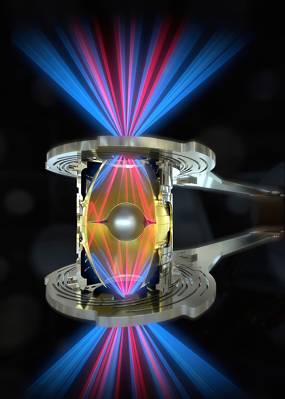
An illustration shows the National Ignition Facility’s lasers strike a canister known as a hohlraum, which helps focus energy on the target within to ignite a plasma and power fusion. Credit: Jacob Long/Lawrence Livermore National Laboratory
One major component of the center’s work is addressing this through incorporating modern data-driven equation-learning methods into the holistic framework. The goal is to use and extend the advances made by team members Bortz, Choi and Lei. This would enable researchers to replace supercomputer simulations of tens of trillions of particles with equations that can be solved on a laptop and still accurately model the physics.
CHaRMNET is confronting another challenge that’s so daunting, it’s been referred to as a curse.
“We’re trying to tame the curse of dimensionality,” Christlieb says.
The good news for CHaRMNET is that there is a fundamental equation that, in theory, lets researchers model plasmas without simplifying assumptions. The bad news is that they need to solve that equation in seven dimensions.
That includes the three regular, familiar spatial dimensions: up and down, side to side and front to back. But researchers also need to account for how fast a particle is moving in each of those dimensions, adding an extra three dimensions. Then they also need to account for time, bringing the number of dimensions to seven.
That’s a lot, computationally and mathematically. But the CHaRMNET team believes they can build on recent advances in math, science, engineering and computation to dispel that curse. In doing so, they’ll also be training the MMICC’s students, postdoctoral researchers and early-career faculty on the wizardry they’ll need to put the new model to work on many important problems going forward.
“I’m excited to see the growth of a close, vibrant research community across our member institutions, especially among our earlier-career researchers,” Hittinger says. “It will be really rewarding to see them build lasting collaborations and seed the next generation of researchers in the field.”
The researchers believe all of this will help usher in the dawn of fusion, which Christlieb believes is closer than it’s ever been. He also knows others have had a similar optimism before, but this is the first time that CHaRMNET has been around to tame curses and help lift fusion’s daybreak over the horizon.
“There’s an old joke that ‘fusion is the energy of the future — and always will be,’” Christlieb says. “However, we may finally be seeing what was once thought to be science fiction turn into science fact.”
Banner image: A computer simulation of plasma inside a device called a tokamak, one of the leading technologies in development for fusion energy. Credit: Walter Guttenfelder/Princeton Plasma Physics Laboratory and Filippo Scotti/Lawrence Livermore National Laboratory